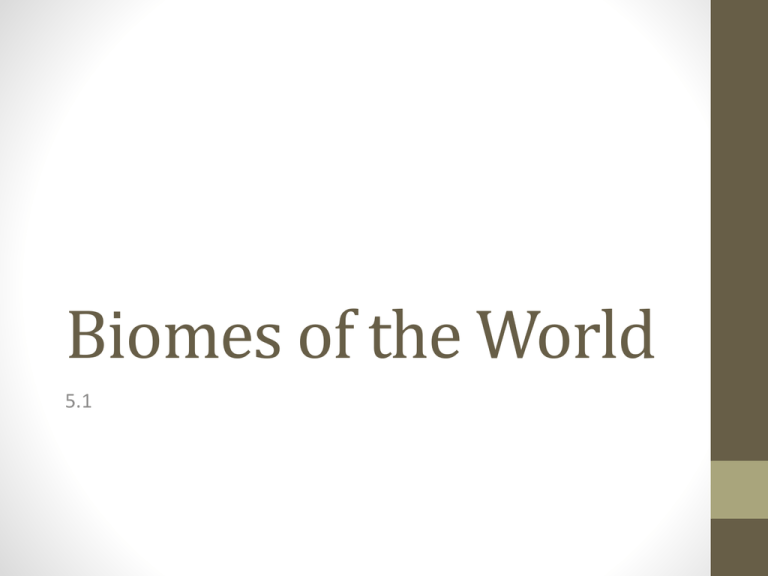Biomes of the World
advertisement

Biomes of the World 5.1 What is a Biome? -The earth has many ecosystems -Scientists group ecosystems into larger areas called Biomes -There are two main categories of Biomes: -Terrestrial (land) -Aquatic (water) Terrestrial Biomes • The Earth has 10 major land biomes: • • • • • • • • • • Tropical Rain Forests Deciduous Forests Coniferous Forests Temperate Grasslands Savannas Chaparral Deserts Tundra Mountains Polar Ice Terrestrial Biomes • Each biome is characterized by a particular climate • What makes the climate? • Average annual temperatures • Amounts of precipitation • Both help to determine the types of plants that can grow there • The plants, in turn, help determine what types of animals can live in each biome Diversity in Biomes • The total diversity of biomes is determined largely by the amount of precipitation and average temperature • Living things need water to survive • The desert and tundra biomes both get very little precipitation, therefore have less diversity • Rainforests get a lot of rain and have hot, humid temperatures • This makes the rain forests the most diverse ecosystems on Earth Location • Biomes located closer to the equator have higher temperatures • Biomes are divided by latitude and location • Polar Zone – farthest from equator • Temperate Zone – Warmer than the polar zone • Tropical Zone – Closest to equator • As the latitude increases, the temperature decreases Aquatic Biomes • Make up more than 70% of the Earth’s surface • Aquatic biomes are not grouped by climate • They are grouped by water depth and salinity • Salinity is the amount of salt dissolved in the water • Rainfall and temperature also affect aquatic biomes • 2 main groups of Aquatic biomes • Freshwater • Saltwater Aquatic Types • Freshwater • • • • • Rivers Streams Ponds Lakes Swamps • Saltwater • • • • Oceans Estuaries Coral Reefs Saltwater Marshes Salinity • All biomes contain some dissolved salt and other minerals • However, oceans contain more dissolved salt than the water found in freshwater systems • This salinity is measured in parts per thousand • The salinity of ocean water is about 30 parts per thousand • The salinity of freshwater biomes is about 0.5 parts per thousand or less Depth • The depth of water also determines what kinds of organisms can survive there • In areas where sunlight can reach, more organisms can live there • Aquatic plants use sunlight to create food • As sunlight decreases with depth, the plant and animal life decreases • In the deep ocean, the water is too dark for photosynthesis Scientists and Biomes • Scientists study biomes to learn more about how organisms survive in different habitats • They investigate how organisms have adapted to temperature, rainfall, water depth, and salinity • They also study how land biomes affect aquatic biomes • Biomes are fragile and need protected Vocabulary • • • • • • Biome Terrestrial Aquatic Salinity Saltwater Freshwater







